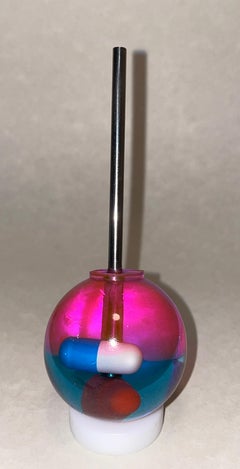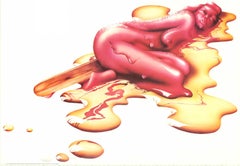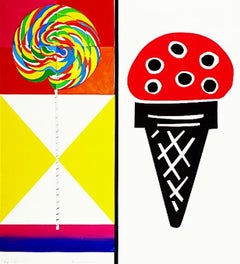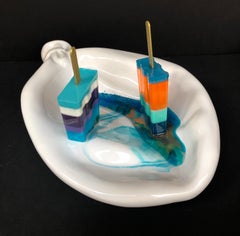Lolly Pop
2010s Contemporary Abstract Sculptures
Stainless Steel
1970s Pop Art Nude Prints
Lithograph
Early 2000s Hard-Edge Mixed Media
Archival Paper, Color
Philomena MaranoBig Lolly & Cone, colorful, bold, candy, abstract, hard edge, playful, pop art, 2005
Recent Sales
2010s Pop Art Still-life Sculptures
Ceramic, Epoxy Resin, Glitter, Ink
2010s Pop Art Abstract Sculptures
Resin
2010s Pop Art Abstract Sculptures
Resin
2010s Pop Art Abstract Sculptures
Resin
2010s Pop Art Abstract Sculptures
Resin
2010s Pop Art Still-life Sculptures
Ceramic, Resin, Epoxy Resin, Glitter, Ink
2010s Pop Art Figurative Sculptures
Resin
2010s Pop Art Still-life Sculptures
Resin, Epoxy Resin, Ink
2010s Pop Art Still-life Sculptures
Ceramic, Resin, Epoxy Resin, Glitter, Ink
2010s Pop Art Abstract Sculptures
Resin
2010s Pop Art Abstract Sculptures
Resin
2010s Pop Art Abstract Sculptures
Resin
2010s Pop Art Abstract Sculptures
Resin
2010s Pop Art Abstract Sculptures
Resin
2010s Pop Art Abstract Sculptures
Resin
2010s Pop Art Abstract Sculptures
Resin
2010s Pop Art Abstract Sculptures
Resin
2010s Pop Art Abstract Sculptures
Resin
2010s Pop Art Abstract Sculptures
Resin
2010s Pop Art Abstract Sculptures
Resin
2010s Pop Art Still-life Sculptures
Ceramic, Resin, Epoxy Resin, Glitter, Ink
2010s Pop Art Figurative Sculptures
Resin
2010s Pop Art Still-life Sculptures
Resin, Epoxy Resin, Ink
2010s Pop Art Still-life Sculptures
Resin, Epoxy Resin, Ink
2010s Pop Art Still-life Sculptures
Resin, Epoxy Resin, Ink
2010s Pop Art Still-life Sculptures
Resin, Epoxy Resin, Ink, Wood Panel
People Also Browsed
2010s Contemporary Nude Photography
Archival Pigment
Antique 15th Century and Earlier African Natural Specimens
Bone
1990s Contemporary Black and White Photography
Photographic Film, Photographic Paper, Silver Gelatin
2010s Contemporary Nude Photography
Archival Pigment, Rag Paper
2010s Contemporary Nude Photography
Archival Pigment, Rag Paper
2010s Contemporary Nude Photography
Archival Pigment, Rag Paper
21st Century and Contemporary Contemporary Nude Photography
Photographic Paper, Pigment
1960s American Modern Nude Prints
Offset
1980s Contemporary Figurative Photography
Photographic Film, Archival Paper, Photographic Paper, Black and White, ...
1980s Contemporary Black and White Photography
Photographic Film, Archival Paper, Photographic Paper, Black and White, ...
21st Century and Contemporary Pop Art Figurative Prints
Enamel, Cut Steel
21st Century and Contemporary Pop Art Figurative Prints
Lithograph
1980s Pop Art Nude Prints
Steel
1970s Pop Art Figurative Prints
Lithograph
1980s Pop Art Nude Prints
Screen
Mid-20th Century Pop Art Figurative Paintings
Canvas, Oil
Lolly Pop For Sale on 1stDibs
How Much is a Lolly Pop?
A Close Look at Pop Art Art
Perhaps one of the most influential contemporary art movements, Pop art emerged in the 1950s. In stark contrast to traditional artistic practice, its practitioners drew on imagery from popular culture — comic books, advertising, product packaging and other commercial media — to create original Pop art paintings, prints and sculptures that celebrated ordinary life in the most literal way.
ORIGINS OF POP ART
- Started in Britain in the 1950s, flourished in 1960s-era America
- “This is Tomorrow,” at London's Whitechapel Gallery in 1956, was reportedly the first Pop art exhibition
- A reaction to postwar mass consumerism
- Transitioning away from Abstract Expressionism
- Informed by neo-Dada and artists such as Jasper Johns and Robert Rauschenberg; influenced postmodernism and Photorealism
CHARACTERISTICS OF POP ART
- Bold imagery
- Bright, vivid colors
- Straightforward concepts
- Engagement with popular culture
- Incorporation of everyday objects from advertisements, cartoons, comic books and other popular mass media
POP ARTISTS TO KNOW
- Richard Hamilton
- Andy Warhol
- Marta Minujín
- Claes Oldenburg
- Eduardo Paolozzi
- Rosalyn Drexler
- James Rosenquist
- Peter Blake
- Roy Lichtenstein
ORIGINAL POP ART ON 1STDIBS
The Pop art movement started in the United Kingdom as a reaction, both positive and critical, to the period’s consumerism. Its goal was to put popular culture on the same level as so-called high culture.
Richard Hamilton’s 1956 collage Just what is it that makes today’s homes so different, so appealing? is widely believed to have kickstarted this unconventional new style.
Pop art works are distinguished by their bold imagery, bright colors and seemingly commonplace subject matter. Practitioners sought to challenge the status quo, breaking with the perceived elitism of the previously dominant Abstract Expressionism and making statements about current events. Other key characteristics of Pop art include appropriation of imagery and techniques from popular and commercial culture; use of different media and formats; repetition in imagery and iconography; incorporation of mundane objects from advertisements, cartoons and other popular media; hard edges; and ironic and witty treatment of subject matter.
Although British artists launched the movement, they were soon overshadowed by their American counterparts. Pop art is perhaps most closely identified with American Pop artist Andy Warhol, whose clever appropriation of motifs and images helped to transform the artistic style into a lifestyle. Most of the best-known American artists associated with Pop art started in commercial art (Warhol made whimsical drawings as a hobby during his early years as a commercial illustrator), a background that helped them in merging high and popular culture.
Roy Lichtenstein was another prominent Pop artist that was active in the United States. Much like Warhol, Lichtenstein drew his subjects from print media, particularly comic strips, producing paintings and sculptures characterized by primary colors, bold outlines and halftone dots, elements appropriated from commercial printing. Recontextualizing a lowbrow image by importing it into a fine-art context was a trademark of his style. Neo-Pop artists like Jeff Koons and Takashi Murakami further blurred the line between art and popular culture.
Pop art rose to prominence largely through the work of a handful of men creating works that were unemotional and distanced — in other words, stereotypically masculine. However, there were many important female Pop artists, such as Rosalyn Drexler, whose significant contributions to the movement are recognized today. Best known for her work as a playwright and novelist, Drexler also created paintings and collages embodying Pop art themes and stylistic features.
Read more about the history of Pop art and the style’s famous artists, and browse the collection of original Pop art paintings, prints, photography and other works for sale on 1stDibs.
Finding the Right Sculptures for You
The history of sculpture as we know it is believed to have origins in Ancient Greece, while small sculptural carvings are among the most common examples of prehistoric art. In short, sculpture as a fine art has been with us forever. A powerful three-dimensional means of creative expression, sculpture has long been most frequently associated with religion — consider the limestone Great Sphinx in Giza, Egypt — while the tradition of collecting sculpture, which has also been traced back to Greece as well as to China, far precedes the emergence of museums.
Technique and materials in sculpture have changed over time. Stone sculpture, which essentially began as images carved into cave walls, is as old as human civilization itself. The majority of surviving sculpted works from ancient cultures are stone. Traditionally, this material and pottery as well as metal — bronze in particular — were among the most common materials associated with this field of visual art. Artists have long sought new ways and materials in order to make sculptures and express their ideas. Material, after all, is the vehicle through which artists express themselves, or at least work out the problems knocking around in their heads. It also allows them to push the boundaries of form, subverting our expectations and upending convention. As an influential sculptor as much as he was a revolutionary painter and printmaker, Pablo Picasso worked with everything from wire to wood to bicycle seats.
If you are a lover of art and antiques or are thinking of bringing a work of sculpture into your home for the first time, there are several details to keep in mind. As with all other works of art, think about what you like. What speaks to you? Visit local galleries and museums. Take in works of public art and art fairs when you can and find out what kind of sculpture you like. When you’ve come to a decision about a specific work, try to find out all you can about the piece, and if you’re not buying from a sculptor directly, work with an art expert to confirm the work’s authenticity.
And when you bring your sculpture home, remember: No matter how big or small your new addition is, it will make a statement in your space. Large- and even medium-sized sculptures can be heavy, so hire some professional art handlers as necessary and find a good place in your home for your piece. Whether you’re installing a towering new figurative sculpture — a colorful character by KAWS or hyperreal work by Carole A. Feuerman, perhaps — or an abstract work by Won Lee, you’ll want the sculpture to be safe from being knocked over. (You’ll find that most sculptures should be displayed at eye level, while some large busts look best from below.)
On 1stDibs, find a broad range of exceptional sculptures for sale. Browse works by your favorite creator, style, period or other attribute.




